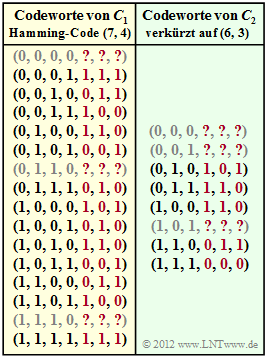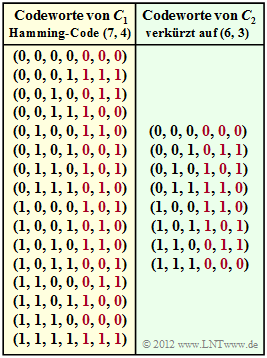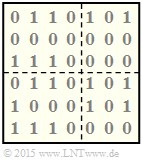Exercise 4.6: Product Code Generation
A $\rm product code \ (42, \ 12)$ shall be generated, based on the following component codes:
- the Hamming code $\rm HC \ (7, \ 4, \ 3)$ ⇒ $\mathcal{C}_1$,
- the truncated Hamming code $\rm HC \ (6, \ 3, \ 3)$ ⇒ $\mathcal{C}_2$.
The corresponding code tables are given on the right, with three rows incomplete in each case. These are to be completed by you.
The codeword belonging to an information block $\underline{u}$ generally results according to the equation $\underline{x} = \underline{u} \cdot \mathbf{G}$. As in the "Exercise 4.6Z" following generator matrices are assumed here:
- $${ \boldsymbol{\rm G}}_1 = \begin{pmatrix} 1 &0 &0 &0 &1 &0 &1 \\ 0 &1 &0 &0 &1 &1 &0 \\ 0 &0 &1 &0 &0 &1 &1 \\ 0 &0 &0 &1 &1 &1 &1 \end{pmatrix} \hspace{0.05cm},\hspace{0.8cm} { \boldsymbol{\rm G}}_2 = \begin{pmatrix} 1 &0 &0 &1 &1 &0 \\ 0 &1 &0 &1 &0 &1 \\ 0 &0 &1 &0 &1 &1 \end{pmatrix} \hspace{0.05cm}.$$
Throughout the exercise, apply to the information block:
- $${ \boldsymbol{\rm U}} = \begin{pmatrix} 0 &1 &1 &0 \\ 0 &0 &0 &0 \\ 1 &1 &1 &0 \end{pmatrix} \hspace{0.05cm}.$$
Searched for according to the nomenclature on page "Basic structure of a product code":
- the parity-check matrix $\mathbf{P}^{(1)}$ with respect to the horizontal code $\mathcal{C}_1$,
- the parity-check matrix $\mathbf{P}^{(2)}$ with respect to the vertical code $\mathcal{C}_2$,
- the checks–on–checks matrix $\mathbf{P}^{(12)}$.
Hints:
- This exercise belongs to the chapter "Basic structure of a product code".
- Reference is made in particular to the page "Basic structure of a product code".
- The two component codes are also covered in the Aufgabe 4.6Z .
Questions
Solution
In general $\underline{x} = \underline{u} \cdot \mathbf{G}$. From this follows for
- the first row vector:
- $$\begin{pmatrix} 0 &1 &1 &0 \end{pmatrix} \cdot \begin{pmatrix} 1 &0 &0 &0 &1 &0 &1 \\ 0 &1 &0 &0 &1 &1 &0 \\ 0 &0 &1 &0 &0 &1 &1 \\ 0 &0 &0 &1 &1 &1 &1 \end{pmatrix} =\begin{pmatrix} 0 &1 &1 &0 &1 &0 &1 \end{pmatrix} \hspace{0.05cm},$$
- the second row vector:
- $$\begin{pmatrix} 0 &0 &0 &0 \end{pmatrix} \cdot \begin{pmatrix} 1 &0 &0 &0 &1 &0 &1 \\ 0 &1 &0 &0 &1 &1 &0 \\ 0 &0 &1 &0 &0 &1 &1 \\ 0 &0 &0 &1 &1 &1 &1 \end{pmatrix} =\begin{pmatrix} 0 &0 &0 &0 &0 &0 &0 \end{pmatrix} \hspace{0.05cm},$$
- the third row vector:
- $$\begin{pmatrix} 1 &1 &1 &0 \end{pmatrix} \cdot \begin{pmatrix} 1 &0 &0 &0 &1 &0 &1 \\ 0 &1 &0 &0 &1 &1 &0 \\ 0 &0 &1 &0 &0 &1 &1 \\ 0 &0 &0 &1 &1 &1 &1 \end{pmatrix} =\begin{pmatrix} 1 &1 &1 &0 &0 &0 &0 \end{pmatrix} \hspace{0.05cm}.$$
(2) Correct are the proposed solutions 1, 2 and 4:
- $$\begin{pmatrix} 0 &0 &1 \end{pmatrix} \cdot \begin{pmatrix} 1 &0 &0 &1 &1 &0 \\ 0 &1 &0 &1 &0 &1 \\ 0 &0 &1 &0 &1 &1 \end{pmatrix} =\begin{pmatrix} 0 &0 &1 &0 &1 &1 \end{pmatrix} \hspace{0.05cm},$$
- $$\begin{pmatrix} 1 &0 &1 \end{pmatrix} \cdot \begin{pmatrix} 1 &0 &0 &1 &1 &0 \\ 0 &1 &0 &1 &0 &1 \\ 0 &0 &1 &0 &1 &1 \end{pmatrix} =\begin{pmatrix} 1 &0 &1 &1 &0 &1 \end{pmatrix} \hspace{0.05cm}.$$
To this subtask is to be noted further:
- The given first column is correct if only because it coincides with a row (the third) of the generator matrix $\mathbf{G}_2$.
- The third column of the 2D codeword should be identical to the second column, since the same codeword $(1, \, 0, \, 1)$ is assumed.
- However, the given vector $(1, \, 1, \, 0, \, 0, \, 1, \, 1)$ cannot be correct if only because $\mathcal{C}_2$ is a systematic code just like $\mathcal{C}_1$.
- Also the truncated $(6, \ 3, \ 3)$–Hamming code $C_2$ is linear, so that the assignment $\underline{u} = (0, \, 0, \, 0) \ \Rightarrow \ \ \underline{x} = (0, \, 0, \, 0, \, 0)$ can be stated without calculation.
(3) The complete code tables
- of the Hamming code $(7, \ 4, \ 3)$, and
- of the shortened Hamming code $(6, \ 3, \ 3)$ are given on the right.
One can see from this (without it being of interest for this exercise) that the codes considered here each have Hamming distance $d_{\rm min} = 3$.
The left graph shows the result of the whole coding. At the bottom right you can see the checks–on–checks matrix of dimension $3 × 3$.
Concerning the subtask (3) the suggested solutions 1 and 2 are correct:
- It is a coincidence that here in the checks–on–checks matrix two rows and two columns are identical.
- It doesn't matter whether rows 4 to 6 of the total matrix are obtained using the code $\mathcal{C}_1$ or columns 5 to 7 are obtained using the code $\mathcal{C}_2$.


